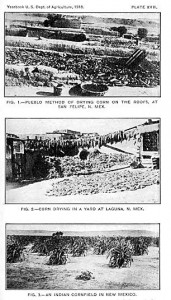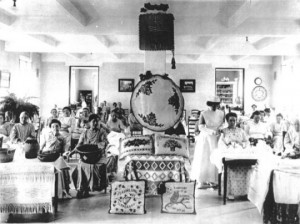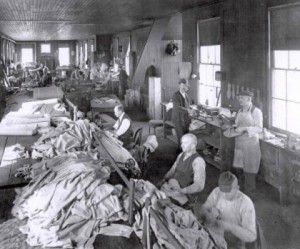
Drying Corn at Laguna, New Mexico, circa 1916, courtesy Yearbook of the United States Department of Agriculture 1918
All asylums operated within budgets, and most had to make difficult choices about which services and personnel to provide and which to skimp on or delete. One reason (among several) that early asylums used patient labor was because it saved money that could then be used elsewhere. Asylum gardens were extremely important to some institutions; they often subsidized food allotments which would have often been inadequate. Dr. Harvey Black, superintendent of Southwestern Lunatic Asylum, wanted three things for his asylum: good food, comfortable clothing, and enough ward attendants. His facility and many others, raised corn, potatoes, and a variety of vegetables; some institutions were able to tend fruit orchards as well.
Patients at the Canton Asylum for Insane Indians helped raise these same items, but wintertime presented a problem for them as it did for the general population. Potatoes, corn, and other starchy vegetables were easy enough to store, but fresh greens and fruits would have disappeared for the winter. Some dried fruits may have been available, but records do not seem to indicate much activity in the way of canning or drying at the asylum. A diet of meat and primarily starchy vegetables could have led to many different health issues, and patients at the Canton Asylum seem to have had a leaning toward sugar addiction. One inspector wrote in 1916: “The only suggestion that I would make, with reference to the ration allowance, is that the supply of sugar be increased. The patients, for some reason, consume more sugar than normal people . . . I have observed this abnormal craving for sugar by patients in other asylums.”
Sugar cravings can indicate thyroid problems, yeast infections,adrenal overload, depression, and a variety of other conditions.The inspector’s comments indicate that something physical was probably going on with the patients at Canton Asylum in addition to any mental issues they may have had.

Women's Sewing Room at Maryland Hospital for the Insane, 1910s, courtesy Spring Grove Hospital Center

Men's Industrial Shop at Maryland Hospital for the Insane, circa 1900, courtesy Spring Grove Hospital Center
______________________________________________________________________________________